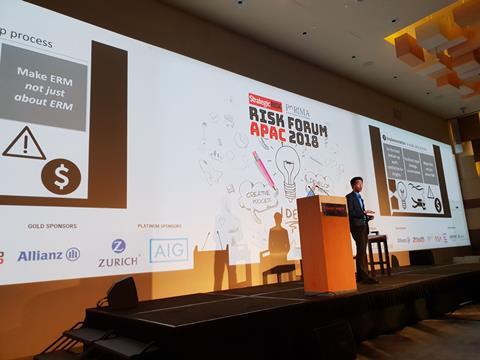Ryan Tan at Singaporean telco StarHub pushes a risk management philosophy about creating an appetite for change

Getting board committees to address the top risks in the register and not being afraid to remould teams to get better results can achieve greater things in risk management, according to StarHub’s Ryan Tan, speaking at Risk Forum APAC 2018 in Singapore today.
“The philosophy is about creating an appetite for change,” said Tan, who is a vice president for mergers and acquisitions, and corporate strategic planning at Singaporean telco company StarHub.
He exhorted risk professionals to explore new ideas, identify pain points with their current systems, undertake key stakeholder mapping and engagement, and take risk – sometimes personally – to start a higher-level conversation.
Tan offered several tips for his peers: firstly, listen to key stakeholders; to build internal credibility; and to a talking head – posing questions rather than focusing on coming up with answers.
Looking for areas of opportunity, rather than just focusing on risks, can also boost the risk function’s profile.
“Some quick wins can add value,” he suggested. “You should consider ‘would this add value if it is discussed strategically at a higher level?’”
He also encouraged risk managers to be more decisive about having the right teams in place – and not be afraid to restructure things and reassign people if results are not forthcoming.
“Do you have the right human capital in place? If your team is not buying in, you might need to make some structural changes. It’s not easy to do, but you might have to do it,” he said.
He stressed the need to move away from a process-heavy approach, giving the example of streamlining seven levels of form filling, which could be simplified into a single document.
Simpler frameworks giving snapshots of risk are more likely to endear the risk function to decision-makers in the business, as well as operational staff, he said.
Tan encouraged risk managers to look beyond their own firms, benchmarking against performance of rivals, in their use of particular aspects of technology or innovative ideas.
Communicating is key, he urged, aligning risk strategy with the line managers.
A good way of doing this, Tan suggested, is for the risk manager to take part in cross-functional projects whenever this adds value “things that touch on risk but other aspects of the business, too”.
The example he gave related to his own cross-functional role, working with legal department on mergers and acquisitions.
“It makes it easier to facilitate those conversations in the business,” he advised.
Getting board-level subcommittees to look into addressing the top risks, as ranked by the risk function, is also a surer way of getting them addressed, Tan suggested.
“We took each of the risks and got the board to deal with them as a deep dive,” said Tan.
“We got the board to deal with them on a rolling basis during the year. Each board sub-committee was tasked with dealing with the various risks,” he added.














No comments yet